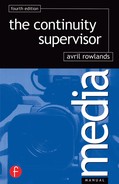It is not necessary for PAs or continuity supervisors to understand the various possibilities for post production and some may find the following chapters hard to follow. I have included them because I am increasingly being asked questions about post production, and as many PAs now have to book the editing facilities, I hope these chapters may be helpful. Unless the programme is under the control of a post production supervisor, or one editor is going to be in charge of the whole process, off-line, on-line and track-laying, it is important to ensure that everybody involved talks to one another and agrees on the technical route to be taken before shooting starts. Otherwise, in an extreme case, it would be possible to arrive at a perfect off-line edit which cannot be related to the master material.
The choice of editing method used for a production depends upon a number of factors: location format, delivery or transmission format, access to particular sorts of equipment, and previous experience of editors and producers all have a bearing on the choice of post production method. In its simplest form, if a programme has been shot on tape, the editing might only involve an on-line linear edit where the editor re-recorded the pictures and sound shot on location in the right order on another roll of videotape. At its most complex, a production shot on film might have its negative transferred on to videotape before using a nonlinear off-line editing system to create three separate versions of the material. Using the videotape masters, two versions might be on-line edited to form a television programme for transmission and a longer version for home video release on DVD and VHS, while, by means of computerised negative cutting lists, the original master negative might be physically cut to form a third version for cinema release.
So what are all these processes?
Although it is being increasingly superseded by computerised systems, it may be helpful to understand the process that takes place in conventional film editing. When you record on videotape the picture and sound are on the same tape or cassette and you can play them back straightaway. When using film, the pictures are shot by the camera onto film stock and the sound is recorded on a separate tape recorder onto quarter-inch wide magnetic tape or DAT. The sound can be played back immediately, but the picture cannot until the exposed film has been processed at a film laboratory.
Before any editing can take place, the sound has to be rerecorded onto magnetic sound film, of either 16mm or 35mm width, according to the gauge used for the picture. Once this is done, the picture and sound are synchronised by a film editing assistant and then viewed by the producer, director and editor so that a final selection of takes may be made. After viewing, an assistant breaks down the rolls of picture and sound, physically cutting them up into individual shots for easy access by the editor and the editing process begins.
The editing is done by joining these shots together in whatever order is decided upon by the director and editor. Shots can be experimented with in any order, and they can be lengthened, shortened, replaced or re-cut at any point. It does not matter what state the cutting copy gets into: it is only a guide for the negative cutter who cuts the original camera negative only after all the creative decisions have been made and the picture is locked off. This system allows immense flexibility. It means that changes can be made at any time until the negative is cut.
At first sight linear videotape editing seems to be simpler than film editing. Sound and picture are already in sync on the same physical piece of tape, and all the editor has to do is to re-record the sections wanted in the right order onto another roll of tape. This gives us pictures and sound of second generation. Each time material is copied on to a new generation of analogue videotape you lose both picture and sound quality. The quality lost in a digital edit suite is imperceptible, but the cost of on-line digital editing can be prohibitive which is why most complex programmes make use of off-line editing.
Increasingly, in a computer orientated world, pictures and sound are digitised into systems such as Avid, Lightworks and Media 100. Once the pictures are in the computer, they can be manipulated with enormous flexibility in much the same way as text on a word processor.
